| Designation: | CAV-100 |
 |
|---|---|---|
| Manufacturer: | NP Aerospace Ltd | |
| Product type: | Auxiliary Vehicles | |
| Name: | Patrol Vehicle |
Following a competition in the spring of 1991, the British MoD placed a contract valued at about GBP50 million with the now NP Aerospace, for the supply of about 1,000 lightly protected 4 × 4 vehicles for the British Army.
The original contract covered the development of prototype vehicles for validation of the light armoured concept and the engineering systems of the vehicle assembly.
The new light armoured vehicle is based on the Land Rover Defender (4 × 4) chassis with NP Aerospace fitting the special ballistic protection system, which is an integral structure manufactured from advanced fibre-reinforced composite materials.
Typical roles of this vehicle include internal security, ambulance, explosive ordnance disposal, logistics, peacekeeping, communications and use by relief agencies in high-threat areas.
Early in 1993, 16 CAV 100 vehicles were purchased by the United Nations High Commissioner for Refugees (UNHCR) to protect relief workers in Bosnia. These were built and delivered in less than four weeks. Three CAV 100s were supplied to the BBC for use in Yugoslavia.
Early in 1994, it was announced that the French Ministère des Affaires had selected the CAV 100D light armoured vehicle to protect diplomatic personnel, with the initial order being for three vehicles.
Two versions were delivered, VIP and escort, with both versions based on the proven Land Rover Defender 110 (4 × 4) chassis.
These CAV 100Ds are used by French embassy personnel operating in various trouble spots around the world.
In 1994, the Canadian Department of National Defence ordered three CAV 100D armoured vehicles to be used in Bosnia. These were delivered in left-hand drive configuration, powered by the Land Rover 200 Tdi 2.5 litre diesel engine and fitted with the optional steel mesh riot protection window system. This includes a mesh cover for the windscreen that can be lowered and which is operated from inside the vehicle.
It is estimated that about 1,200 light armoured vehicles on the Land Rover Defender 110 (4 × 4) chassis, with the largest customer being the British Army. The British Army vehicles have a different build standard and specification from the export vehicles. Although originally developed for use in Northern Ireland, the CAV 100 has seen extensive service with the British Army in the Balkans and more recently in Afghanistan and Iraq.
Finland has purchased two CAV 100 series vehicles for use in the former Yugoslavia.
Late in 2006 the UK MoD stated that the British Army took delivery of a total of 991 'Snatch' vehicles.
From late 2006 in British Army service the 'Snatch' vehicle has been supplemented by the Mastiff (6 × 6) and Vector (6 × 6) protected patrol vehicles (PVP). These have a higher level of protection, greater internal volume and a higher level of cross-country mobility. Description
The CAV 100 vehicle protection system is an armour concept based on S2 Glass composite bonded assembly which can be fitted to a wide range of wheeled vehicles.
The layout of the vehicle is conventional, with the engine at the front, driver and commander in the centre (with both left- and right-hand drive versions available) and twin doors at the rear. There is accommodation for four or six men in the rear on seats down either side.
Transparent armour is fitted to the windscreen, side and rear windows and this comprises laminated glass/'Hardcote' Polycarbonate/PVB construction. SHU (Self-Healing Urethane) coating is also available as an option.
The manufacturing programme for the armour is based on NP Aerospace's own extensive experience in composites and also incorporates specific technology licensed from Owens Corning Fibreglas in the US.
The S2 Glass has been found to be most effective in achieving the design solutions for the projects that have been addressed so far, but the capability and database background to use other reinforcements, such as E glass, aramid, hybrids and combinations with ceramics, is available.
The ballistic protection level can be tailored to defeat the specific threat or range of threats covering fragmentation, 5.56 mm or 7.62 mm small arms fire and blast protection.
By virtually eliminating metal from the armour protection system, the behind-armour effects are claimed to be substantially reduced and the risk of spall damage is almost nil. According to the manufacturer, the armour is good against multiple hits and effective repair schemes have been validated. It is also up to 20 per cent lighter than metal armour systems.
The standard Land Rover Defender (4 × 4) chassis is fitted with a modular monocoque body to which the doors, windscreen and other subcomponents are added. A monocoque structure was selected to provide the maximum possible protection and structural integrity.
The armour concept is based on the use of high-performance glass-reinforced composites made by high-pressure compression moulding processes.
Armour components are moulded as contoured shapes and flat panels for combination into assemblies and subassemblies using advanced adhesive bonding techniques.
Standard equipment includes a PROMEL explosion protection system for the fuel tank, an in-tank electric fuel pump via a full flow filter, a water-to-air vehicle heater with a two-speed fan in the front cabin, and an extractor/ventilator fitted in the rear cabin, which is capable of moving air at the rate of 300 m3/h or more. Electrical suppression is to ECE 10 standard but as an option it can be upgraded to DEF-STAN 5941.
The standard version is powered by a 3,500 cc V-8 petrol engine, while the CAV 100D is powered by a 2.5 litre Tdi diesel engine, which gives a maximum road range of 700 km and an average road speed of 120 km/h.
All CAV 100 vehicles are now fitted with an air conditioning system as standard.
Optional equipment includes a surveillance roof hatch, document ports, additional windows for rear cab, riot/public disorder protection, seating options for up to eight crew, enhanced comfort front seats, paintwork colour options (for example NATO green/sand/and so on) and sign-writing to end-user requirements.
S2 Glass is the registered trademark of Owens Corning Fibreglas Corporation. Variants
While the CAV 100 series relates to the Land Rover Defender production (4 × 4) chassis, the CAV 200 series covers armour system assemblies based on other vehicle chassis configurations. The CAV 300 series covers armour components and panels.
This has the rear configured for the VIP role with seats for two senior personnel plus seats for two bodyguards.
This has a rear configured for two stretcher cases, one either side, and attendant medical personnel, plus overhead storage lockers and resuscitation equipment.
This is similar to the standard vehicle but has specialised police equipment such as blue flashing lights, rotating spotlights and additional communications equipment.
In 1995, NP Aerospace completed the first prototype of the CAV 201 (4 × 4) armoured personnel carrier, which is based on the chassis of the well-known Mercedes-Benz G-Wagon 461 (4 × 4) vehicle.
This model has a similar layout to the CAV 100 with gross vehicle weight being 3,800 kg and unladen weight being 3,000 kg. It is offered with a 2,298 cc petrol engine (maximum road speed 135 km/h) or a 2,874 cc diesel engine which gives a maximum speed of 120 km/h.
Both engine options are coupled to a five-speed manual transmission and a two-speed transfer box and the driver can select 4 × 4 or 4 × 2 drive depending on the tactical situation. Air conditioning is standard, as is a 96 litre fuel tank.
For operations in the Balkans some British Army vehicles were observed fitted with a spare wheel and tyre mounted on the front of the hull and an anti-wire cutting device installed on the left side of the hull.
Within the British Army, these vehicles are commonly known as 'Snatch' vehicles and for use in Iraq some have been upgrade to the 'Snatch - Chile' standard. These retain their Bilsen screen above the rear troop compartment and the wire cutter mounted towards the front of the vehicle.
The modifications include the installation of an air-conditioning system and a special thermal cover to the top, sides and rear of the troop compartment.
More recently the 'Snatch' vehicles deployed to Afghanistan and Iraq have been further enhanced including the installation of electronic warfare (EW) equipment to reduce the threat from improved explosive devices.
|
||||||||
|
|||||||||||||||||||||
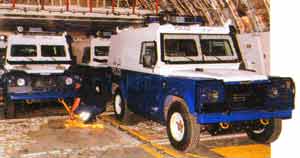 |
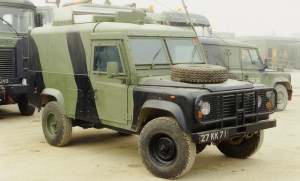 |
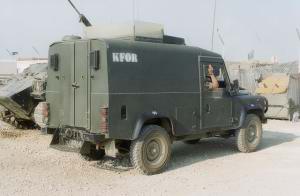 |
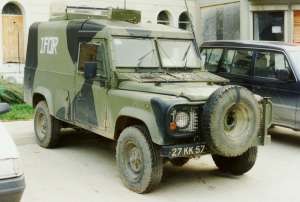 |
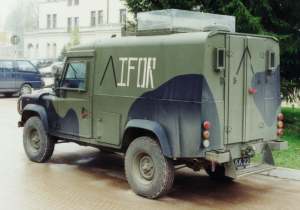 |
 |




